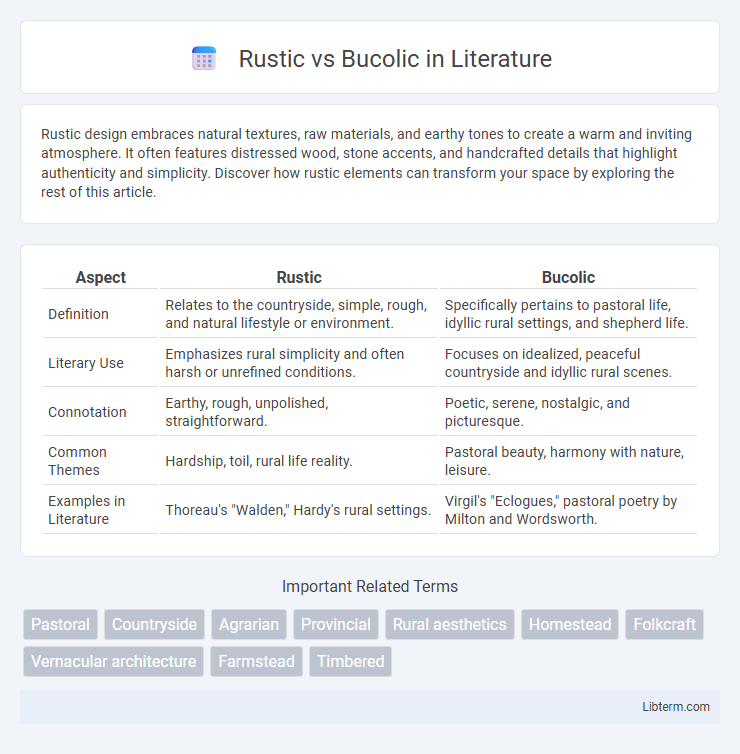Rustic design embraces natural textures, raw materials, and earthy tones to create a warm and inviting atmosphere. It often features distressed wood, stone accents, and handcrafted details that highlight authenticity and simplicity. Discover how rustic elements can transform your space by exploring the rest of this article.
Table of Comparison
| Aspect | Rustic | Bucolic |
|---|---|---|
| Definition | Relates to the countryside, simple, rough, and natural lifestyle or environment. | Specifically pertains to pastoral life, idyllic rural settings, and shepherd life. |
| Literary Use | Emphasizes rural simplicity and often harsh or unrefined conditions. | Focuses on idealized, peaceful countryside and idyllic rural scenes. |
| Connotation | Earthy, rough, unpolished, straightforward. | Poetic, serene, nostalgic, and picturesque. |
| Common Themes | Hardship, toil, rural life reality. | Pastoral beauty, harmony with nature, leisure. |
| Examples in Literature | Thoreau's "Walden," Hardy's rural settings. | Virgil's "Eclogues," pastoral poetry by Milton and Wordsworth. |
Understanding Rustic and Bucolic: Key Definitions
Rustic describes a style or atmosphere characterized by simplicity, roughness, and natural materials, often associated with countryside living and handcrafted elements. Bucolic specifically refers to the charm and peacefulness of rural life, evoking pastoral scenes with shepherds, fields, and idyllic landscapes. Understanding the distinction highlights Rustic's emphasis on textured, unrefined aesthetics versus Bucolic's focus on serene, pastoral beauty in rural settings.
Historical Origins of Rustic and Bucolic Styles
Rustic style traces its historical origins to early rural craftsmanship and traditional farmhouses, emphasizing natural materials like wood and stone that evoke a rugged, handmade aesthetic. Bucolic style derives from ancient Greek and Roman poetry that idealized pastoral landscapes and rural life, inspiring art and design focused on serene countryside scenes and harmonious nature. Both styles reflect deep connections to rural heritage, with Rustic highlighting physical construction and Bucolic embodying the poetic romanticism of agrarian simplicity.
Visual Characteristics: Rustic vs Bucolic Aesthetics
Rustic aesthetics emphasize rough-hewn textures, weathered wood, natural stone, and earthy tones that evoke a handcrafted, unrefined charm. Bucolic visuals feature expansive green fields, pastoral landscapes, flowering meadows, and serene countryside settings that convey tranquility and idyllic rural life. The contrast lies in rustic's tactile, rugged elements versus bucolic's soft, picturesque, and harmonious nature scenes.
Architectural Elements: Comparing Rustic and Bucolic Design
Rustic design emphasizes rugged, natural materials such as exposed wooden beams, stone walls, and handcrafted furniture, creating a cozy, earthy atmosphere. Bucolic design incorporates pastoral elements like thatched roofs, open verandas, and floral motifs, evoking a serene countryside charm. Both styles prioritize harmony with nature but differ in architectural details, where rustic leans toward robust textures and bucolic favors gentle, picturesque forms.
Furniture Choices: Distinguishing Rustic from Bucolic
Rustic furniture features robust wood pieces with natural textures and distressed finishes that emphasize ruggedness and practicality. Bucolic furniture highlights softer lines with handcrafted elements, incorporating floral patterns and vintage accents to evoke pastoral charm. Choosing rustic means embracing raw, hearty designs, whereas bucolic favors gentle, picturesque aesthetics inspired by countryside living.
Color Palettes: Earthy Tones vs Pastoral Hues
Rustic color palettes emphasize earthy tones such as deep browns, burnt sienna, and moss green, evoking a warm, grounded ambiance reminiscent of natural wood and stone elements. Bucolic palettes favor pastoral hues like soft pastels, gentle greens, and sky blues that capture the serene, idyllic charm of countryside landscapes. Both styles draw inspiration from nature, but rustic colors provide a robust, textured feel while bucolic tones create a light, airy, and peaceful atmosphere.
Outdoor Spaces: Rustic Retreats vs Bucolic Landscapes
Rustic retreats emphasize rugged, natural materials and weathered textures to create cozy outdoor spaces that blend rugged charm with functionality. Bucolic landscapes showcase gently rolling hills, vibrant meadows, and pastoral scenes designed to evoke peaceful, idyllic countryside living. Both styles prioritize natural elements but rustic spaces highlight handcrafted details, while bucolic settings celebrate expansive, tranquil vistas.
Lifestyle and Ambiance: What Each Style Evokes
Rustic lifestyle emphasizes a rugged, unrefined ambiance with natural materials like exposed wood and stone, evoking a sense of simplicity and durability often found in mountain cabins or country lodges. Bucolic style centers on pastoral charm, highlighting serene, idyllic rural settings with soft colors, floral motifs, and open spaces that promote tranquility and a connection to nature. Both styles create a warm, inviting atmosphere but differ in their portrayal of countryside living--rustic exudes raw, earthy authenticity, while bucolic captures peaceful, romanticized rural life.
Popular Uses: Where Rustic or Bucolic Works Best
Rustic style excels in interior design, furniture, and home decor, creating a warm, natural atmosphere often found in cabins, lodges, and country homes. Bucolic is best suited for describing landscapes, literature, and art that evoke idyllic rural life, pastoral scenes, and countryside tranquility. Rustic emphasizes a handcrafted, sturdy aesthetic, while bucolic highlights poetic, serene rural charm.
How to Choose: Deciding Between Rustic and Bucolic Decor
Choosing between rustic and bucolic decor depends on the desired ambiance and key design elements; rustic decor emphasizes raw, natural materials like reclaimed wood and stone for a rugged, cozy feel, while bucolic decor incorporates softer, pastoral elements with floral patterns, gentle earth tones, and vintage accessories that evoke countryside charm. Consider the space's architectural style and lighting--rustic decor suits open, sturdy spaces with warm, muted lighting, whereas bucolic works well in airy, sunlit rooms aiming for a tranquil, idyllic atmosphere. Prioritize decor components like furniture texture, color palette, and accent pieces to align with either the robust, handcrafted vibe of rustic or the romantic, serene essence of bucolic style.
Rustic Infographic

 libterm.com
libterm.com